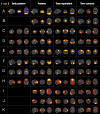Emergence of resting state networks in the preterm human brain
- PMID: 21041625
- PMCID: PMC2993415
- DOI: 10.1073/pnas.1007921107
Emergence of resting state networks in the preterm human brain
Abstract
The functions of the resting state networks (RSNs) revealed by functional MRI remain unclear, but it has seemed possible that networks emerge in parallel with the development of related cognitive functions. We tested the alternative hypothesis: that the full repertoire of resting state dynamics emerges during the period of rapid neural growth before the normal time of birth at term (around 40 wk of gestation). We used a series of independent analytical techniques to map in detail the development of different networks in 70 infants born between 29 and 43 wk of postmenstrual age (PMA). We characterized and charted the development of RSNs from recognizable but often fragmentary elements at 30 wk of PMA to full facsimiles of adult patterns at term. Visual, auditory, somatosensory, motor, default mode, frontoparietal, and executive control networks developed at different rates; however, by term, complete networks were present, several of which were integrated with thalamic activity. These results place the emergence of RSNs largely during the period of rapid neural growth in the third trimester of gestation, suggesting that they are formed before the acquisition of cognitive competencies in later childhood.
Conflict of interest statement
The authors declare no conflict of interest.
Figures




References
-
- Biswal B, Yetkin FZ, Haughton VM, Hyde JS. Functional connectivity in the motor cortex of resting human brain using echo-planar MRI. Magn Reson Med. 1995;34:537–541. - PubMed
-
- Fox MD, Raichle ME. Spontaneous fluctuations in brain activity observed with functional magnetic resonance imaging. Nat Rev Neurosci. 2007;8:700–711. - PubMed
-
- Fransson P, et al. Spontaneous brain activity in the newborn brain during natural sleep—An fMRI study in infants born at full term. Pediatr Res. 2009;66:301–305. - PubMed
Publication types
MeSH terms
Grants and funding
LinkOut - more resources
Full Text Sources
Medical

